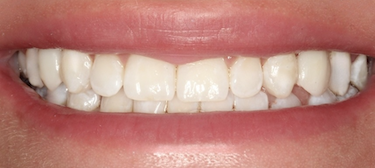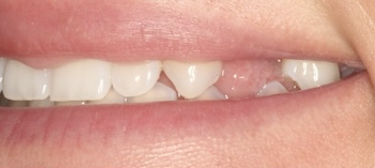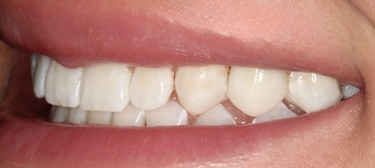A gap in your smile is more than just a cosmetic concern; it can affect how you speak, chew, and even how your other teeth fit together. At Lake Forest Smiles, our highly trained and compassionate cosmetic dentists are here to help you regain function, restore your appearance, and protect your long-term oral health.
We understand the importance of a complete and confident smile in your daily life. If you are dealing with the challenge of one or two missing teeth in a row, dental bridges offer an economical and effective solution that can restore your smile and chewing ability with care and expertise.
If you have missing teeth, call our highly trained and compassionate cosmetic dentists at Lake Forest Smiles today for an appointment!

Before

After

Before

After
Dental Bridges for Tooth Restoration
A dental bridge is a permanent restoration that acts as a bridge between your existing teeth, seamlessly replacing missing ones. Though they look like separate teeth when placed in your mouth, a bridge is actually made up of three or more crowns fused together.
The bridge is supported by healthy teeth (called “abutment teeth”) or by dental implants, depending on your specific needs. The replacement teeth in the middle are carefully crafted to blend in with the color, shape, and size of your natural teeth.
We use durable, high-quality porcelain that not only matches the look of real enamel but also feels natural in your bite. With the right care, your bridge can last for many years, helping you smile, eat, and speak with complete confidence.
Benefits of Dental Bridges
Beyond contributing to the aesthetic appeal of your smile and enhancing your self-confidence, dental bridges offer many benefits, such as:
Restored Chewing Ability
Dental bridges provide the support needed for you to chew, speak, and smile with ease, which means you can enjoy your favorite foods without worry.
Improved Speech
Missing teeth can affect your pronunciation; replacing them helps restore clear, natural speech.
Enhanced Stability
Because they are cemented in place, bridges won’t slip or move the way removable dentures sometimes can.
Maintained Tooth Alignment
Gaps can cause neighboring teeth to drift into empty spaces, leading to bite problems. A bridge helps keep your teeth in their proper positions.
Preserved Facial Shape
Missing teeth can cause the jawbone and facial muscles to lose support, creating a sunken appearance. A bridge helps maintain your natural facial contours.
Quick, Reliable Results
In just two visits, you can go from having missing teeth to enjoying a complete, functional smile.
Types of Dental Bridges We Offer
Not all dental bridges are the same. At Lake Forest Smiles, we offer several types to meet your specific needs:
- Implant-Supported Bridges: Anchored by dental implants rather than natural teeth, these bridges offer exceptional stability and help prevent bone loss in the jaw.
- Traditional Dental Bridges: These are the most common type, anchored to natural teeth on either side of the gap. They are a strong and reliable solution for most patients.
- Cantilever Bridges: Used when there is only one healthy tooth next to the missing tooth. These are less common but can be ideal in specific cases.
- Maryland (Resin-Bonded) Bridges: Instead of using crowns, these bridges use a metal or porcelain framework bonded to the back of adjacent teeth. They are a conservative option for replacing front teeth.
What Can I Expect?
Getting a dental bridge usually involves two appointments. This is usually what patients can expect:
First Visit
- Impressions of your teeth are made in a putty-like material for modeling the bridge.
- Digital copies of your impressions are sent to a lab that will craft your restoration.
While You Wait
- A temporary bridge will be placed in your mouth to prepare and protect your teeth.
- Durable porcelain is used in the lab to expertly craft your permanent dental bridge.
Second Visit
- An examination is conducted to make sure your new bridge has a natural look and a comfortable bite.
- Your bridge is placed, leaving you with a complete smile that can last for many years.
It’s a simple process, but it comes with life-changing results.

Are You a Candidate for a Dental Bridge?
You may be a good candidate for a dental bridge if:
- You have one or more missing teeth in a row.
- You have healthy teeth or implants on either side of the gap to support the bridge.
- Your gums are healthy, with no active gum disease.
- You want a solution that is fixed in place rather than removable.
If you’re unsure whether a bridge or another option, like dental implants, is right for you, our team can guide you through the pros and cons of each based on your lifestyle, budget, and long-term goals.
Caring for Dental Bridges
With proper care and maintenance, your dental bridge can last up to 15 years.
- Avoid using your teeth to open packages or bite on very hard foods, as this could damage the porcelain.
- Brush and floss daily with fluoride toothpaste.
- Floss between your teeth and underneath the bridge using special floss threaders or a water flosser.
- Schedule routine cleanings and checkups so we can monitor your bridge and overall oral health.

Frequently Asked Questions About Dental Bridges
How long does it take to get used to a bridge?
Most patients adjust to their dental bridge within a week or two. Any initial tightness or mild sensitivity typically fades quickly.
Will a bridge look different from my natural teeth?
Not at all! Our bridges are custom-matched to the color, shape, and size of your existing teeth for a seamless look.
Can a bridge replace more than one tooth?
Yes, a bridge can replace several missing teeth in a row as long as there is enough support from your natural teeth or dental implants.
Is getting a bridge painful?
The procedure is performed with local anesthesia, so you’ll be comfortable during your visits. Any post-treatment sensitivity is usually mild and short-lived.
How long does a dental bridge last?
With proper care, most dental bridges last between 10–15 years, and sometimes even longer. Regular checkups and good oral hygiene are the best way to extend the life of your restoration.
How do I clean under my bridge?
You can use floss threaders, special bridge floss, or a water flosser to clean beneath the pontic (the replacement tooth). This helps prevent plaque buildup and gum inflammation.
What’s the difference between a bridge and a denture?
A bridge is fixed in place and doesn’t need to be removed for cleaning. Dentures are removable and may require adhesives. Many patients find bridges feel more natural and stable.
Ditch the Discomfort of Missing Teeth with Lake Forest Smiles
If you’re experiencing the discomfort of broken or missing teeth, call Lake Forest Dental today for a consultation on how we can help you regain a complete, comfortable, and confident smile.

